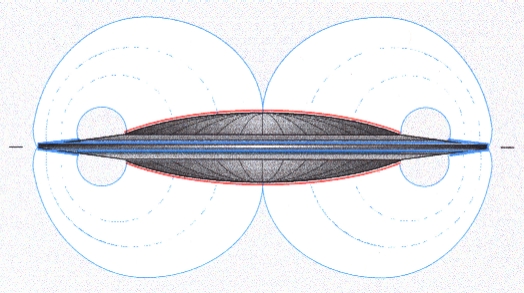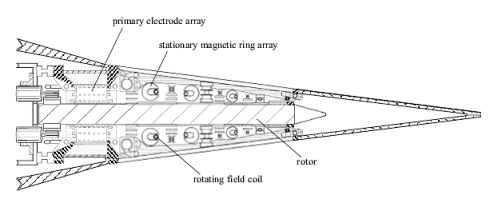Summary:
The Electrodynamic Field (EDF) Generator
is a
patented high-voltage DC motor-generator,
the most remarkable feature of which is that in operation it produces a
high-energy electrodynamic field [or quasi-coherent DC corona or arc
discharge] which completely encloses the machine's conductive housing!
As an integral component of the device's electrical power output circuit,
this external 'open' field is intended to take
advantage of an electric discharge's ability to dissipate and
reabsorb more quantum energy than is required to initiate that
discharge. This natural phenomenon
finally finds explanation in leading-edge micro-electrodynamic
fluctuation theory – as recently refined in the work of Dr. Thomas
Bearden* et al. – which implies an elegant
and valid basis for "permissible electrical power systems that
take EM energy from the vacuum and use it to power loads." *
[ref.: see the Electron Work Theory section of our Power
Plant page.]


The EDF Generator is an exotic variant of the original
Faraday disk dynamo that's made brushless using 'classical' vacuum tube
theory; and electrostatic induction – not
electromagnetic induction – is used to develop the device's full
working DC armature voltage with negligible input electrical power and
with no significant
retarding torque,
whereby high-voltage plane parallel electrode
rings not only fully polarize the armature electrically but effectively
isolate the DC input circuit from the armature's entire operating
current and any associated magnetic losses!
External "bypass" Field output current is then induced to flow by
stimulated thermionic emission means, through heated electron
source assemblies connected between the housing
electron collectors and the electrically
polarized armature, and the load current
thereby made available is limited only by the sources' electron emission
current density rating (as specified by the manufacturer).
Once the treated cathodes of these electron sources are fully heated
by collector current conduction, and the voltage drop across the
attached power resistors stabilizes at a good AC inverter input voltage,
operator electrical input to the warm-up heaters may be discontinued
and no further operator input power is required
in operation. Thus, the EDF Generator
will produce much more electrical energy in operation than it consumes,
and may be described as "over-unity" in nature – in that its efficiency
(by eliminating magnetic losses) is over a classically-calculated 100%.
It may in fact be the world's first self-sustaining
over-unity power plant which taps the zero point
energy on a large scale.
Discussion:
Nearly anyone who wishes to gain an initial understanding of the
Electrodynamic Field Generator, even
a scientist or engineer, is likely to ask for a concise layman's
explanation of "how it works". This isn't easily accomplished, since the
device represents an unorthodox and multidisciplinary technology.
However, the overview presented herein will discuss certain
characteristics of the machine's simplified
electric power generation variant in what is hoped to be the
most direct manner possible. In this case, when people ask the question
above, what they generally mean is: "how can over-unity operation
really be achieved in a 'StarDrive Dynamo'?". It is assumed here
that the reader is already acquainted with certain basic aspects of the
design, and appreciates as well that over-unity operation is an absolute
prerequisite for the viable light-speed propulsive variant we are
working to develop further. . .
As essential background, the formative mechanical design basis of
the EDF Generator is of course the original
Faraday disk dynamo. Strangely enough,
although many have patented 'novel' forms of this simple machine, before
now no one seems to have tried building a more sophisticated variant
that uses electrostatic induction principles to substantially
eliminate magnetic losses. The principal limitation of Faraday's disk
dynamo in its initial form was that, when one or more permanent magnets
were used to pass flux directly through the plane of a solid conductive
rotor, a heavy but rather high-loss current at very low voltage was
produced. The first design improvement was therefore to use rotor-mounted
toroid field coils in order to generate a much higher-voltage
primary current, and a 'segmented' rotor to reduce "eddy current"
resistive losses. The toroid coil configuration
also absolutely minimizes Lenz losses, or the magnetic "drag" that is
experienced by any conventional generator's rotor proportional to the
entire induced load current.
 |
To eliminate the use of brushes, electrostatics and traditional
vacuum tube design and operating principles
were employed. Fortunately, most of the original patent work in this
field has passed into the public domain, so incorporating certain
aspects thereof into the EDF Generator was not an impediment to its
patentability. By using plane-parallel electrode
arrays instead of brushes to energize the rotor, it's possible to limit
that portion of the overall induced rotor current which passes
through the input circuit's field coils to an extremely low level –
effectively isolating them from the output circuit. More
importantly, however, it then becomes possible to thermoelectrically
charge the Generator's housing itself in such a way that it
carries the device's full output current instead! This is done by means
of 72 modular heated electron source assemblies
(in the primary electrode arrays shown above) that essentially
function just like amplifying 'beam power'
electron tubes connected between the
housing collectors and the rotor.
Electron tube:
...electron tube, device consisting of a sealed
enclosure in which electrons flow between electrodes separated either by
a vacuum (in a vacuum tube) or by an ionized gas at low pressure (in a
gas tube). The two principal electrodes of an electron tube are the
cathode and the anode or plate. The simplest vacuum tube, the diode, has
only those two electrodes. When the cathode is heated, it emits a cloud
of electrons, which are attracted by the positive electric polarity of
the anode and constitute the current through the tube. If the cathode is
charged positively with respect to the anode, the electrons are drawn
back to the cathode. However, the anode is not capable of emitting
electrons, so no current can exist; thus the diode acts as a rectifier,
i.e., it allows current to flow in only one direction. In the vacuum
triode a third electrode, the grid, usually made of a fine wire mesh or
similar material, is placed between the cathode and anode. Small voltage
fluctuations, or signals, applied to the grid can result in large
fluctuations in the current between the cathode and the anode. Thus the
triode can act as a signal amplifier, producing output signals some 20
times greater than input. For even greater amplification, additional
grids can be added. Tetrodes, with 2 grids, produce output signals about
600 times greater than input, and pentodes, with 3 grids, 1,500 times.
X-ray tubes maintain a high voltage between a cathode and an anode. This
enables electrons from the cathode to strike the anode at velocities
high enough to produce X rays. A cathode-ray tube can produce electron
beams that strike a screen to produce pictures as in oscilloscopes and
video displays. Gas tubes behave similarly to vacuum tubes but are
designed to handle larger currents or to produce luminous discharges. In
some gas tubes the cathode is not designed as an electron emitter;
conduction occurs when a voltage sufficient to ionize the gas exists
between the anode and the cathode. In these cases the ions and electrons
formed from the gas molecules constitute the current. Electron tubes
have been replaced by solid-state devices, such as transistors, for most
applications. However they are still widely used in high-power
transmitters, some television cameras, specialty audio equipment, and as
oscilloscope and video displays. A klystron is a special kind of vacuum
tube that is a powerful microwave amplifier; it is used to generate
signals for radar and television stations.
The reason for the latter unorthodox design parameter is that it
was desired to actually incorporate a standing
electric arc field or corona discharge into the output circuit,
to take advantage of the electron's inherent ability to absorb "quantum
background energy" – including
zero-point
energy – to virtually any extent necessary to maintain its
eternal
steady-state spin. As a result of a
thorough study of lightning, the inventor of the StarDrive device
reasoned that the electrons comprising any naturally-occurring bolt of
lightning have to recover (or absorb) an amount of ambient
photonic energy equal to that which they expend in transit – in
order to satisfy the Conservation of Energy principle.
In such a case, it really isn't necessary that "we"
do the work of moving charge against a potential gradient;
the work may be done by the charge itself in being attracted along
the potential gradient (or voltage level)! Thus, the primary
arrays 'starve' the collectors of electrons and the rotor distributes
the corresponding negative charge to the housing's peripheral emitter
ring until a continuous spatial Field "leakage" or bypass current ensues
around the housing at a highly elevated voltage.
[Put another way: it is known from electrophysics research
that a typical bolt of lightning comprises a current of 13,000 amps at
about 500 million volts – roughly 6.5 terawatts of power, or the
equivalent of 8.7 billion horsepower! It should
be obvious that a thundercloud system and the ground beneath it do
not jointly conspire to input a corresponding amount of energy
into creating that lightning stroke: Since electrons are
continuously self-motional, it requires far less
energy (for random atmospheric forces, in this case)
to effect a
massive separation of charge than the
total energy released when lightning-borne electrons act to neutralize
that separation of charge.]
And since it's known from welding that it takes even less input
energy to sustain an arc than it does to initiate it, it therefore
becomes possible to create an electrical circuit which continuously
outputs far more energy than it requires as input. This is exactly what
an EDF Generator does – by incorporating a standing arc field or corona
discharge in its output circuit. Using a StarDrive device as our
mechanism, "we" only have to provide sufficient
work-energy to establish and maintain the external Field's potential
gradient, by initiating rotation of the electrically polarized
rotor and bringing the thermoelectric elements up to operating
temperature. The electrons in the electrodynamic field do all the rest
. . .**
** For an in-depth and conclusive analysis of the means by which
all electrons are able to continuously output EM
energy (or do work), by world-reknowned
over-unity authority Dr. Thomas Bearden, click
here.
The above Summary is a good introduction to basic EDF (StarDrive)
Generator design and operation issues which are discussed further in our
detailed
1st Proof-of-Concept Experiment Report.
At the present time, we are assembling a second and definitive PoC
experiment using all-production-spec materials and components. A similar
Report on the testing of this final pre-prototype
EDF Generator power system design
will be forthcoming, as will further news regarding the funding of our
full-scale 24kW Prototype Project.
For a further brief but detailed
[pdf] Technical Overview
of the StarDrive Dynamo's method of operation,
click here.
* * * * *
<<<
to News
page to
StarDrive home page
to
Energy Systems page
...:: İzinsiz alıntı yapılamaz!
Cetin BAL - GSM: +90 05366063183 -Turkey/Denizli ::...
Ana Sayfa ·
Ýndex·
Ziyaretçi
Defteri
 E-Mail
Roket bilimi
E-Mail
Roket bilimi
Time Travel Technology
UFO Technology
Kuantum Fiziđi |


